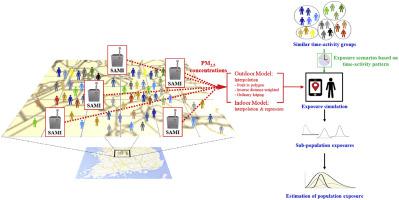Atmospheric Pollution Research ( IF 3.9 ) Pub Date : 2020-08-06 , DOI: 10.1016/j.apr.2020.08.010 Jinhyeon Park , Hyeonsu Ryu , Eunchae Kim , Youngtae Choe , Jung Heo , Jeongil Lee , Seung-Hyun Cho , Kyunghwa Sung , Mansu Cho , Wonho Yang

|
Although fixed ambient air monitoring stations provide data regarding ambient PM2.5 concentrations within a given community, they present limitations in terms of assessing the actual exposure to individuals and populations using time-activity patterns. The population exposure of a community may be estimated by classifying the population according to the time-activity pattern and modeling their exposure. In this study, we provide a possible methodology to assess the population exposure to PM2.5 in a given community. Five field technicians conducted exposure simulations for similar time-activity groups of preschool children, school students, homemakers, office workers, and elderly, with PM2.5 personal exposure monitoring (PEM) equipment, in Guro-gu, Seoul, Korea. The PM2.5 exposure concentrations were modeled by interpolation (point in polygon, inverse distance weighted, and ordinary kriging methods) and regression models using GPS data and a sensor-based air monitoring instrument network, and were compared with the PEM data. The population exposure to PM2.5 was estimated using the population-weighted average through Monte–Carlo simulation. Elderly presented the highest average PM2.5 exposure concentration followed by office workers, homemakers, preschool children, and school students. The correlation between the measured and modeled exposure was good, in the order of ordinary kriging (R2 = 0.822), inverse distance weighted (R2 = 0.747), and point in polygon methods (R2 = 0.721). Thirty-seven percent of the population in a community was exposed to PM2.5 concentrations higher than 35 μg/m3, which is the Korean Atmospheric Environmental Standard for PM2.5 (24-h average). It is suggested that this methodology could be applied to assess the real-time and long-term cumulative exposures of a given community. It is expected that an exposure surveillance system can be developed based on these results.
中文翻译:

使用基于传感器的空气监测工具和类似的时间活动人群评估社区的PM 2.5人群暴露
尽管固定的环境空气监测站提供了有关给定社区内环境PM 2.5浓度的数据,但它们在使用时间活动模式评估实际暴露于个人和人群方面存在局限性。可以通过根据时间活动模式对人群进行分类并对他们的暴露进行建模来估计社区的人群暴露。在这项研究中,我们提供了一种评估特定社区中PM 2.5人群暴露的可能方法。五名现场技术人员对学龄前儿童,小学生,家庭主妇,办公室工作人员和老年人的类似时间活动组的PM 2.5进行了暴露模拟位于韩国首尔九老区的个人暴露监测(PEM)设备。使用GPS数据和基于传感器的空气监测仪器网络,通过插值法(多边形中的点,逆距离加权和常规克里金法)和回归模型对PM 2.5暴露浓度进行建模,并将其与PEM数据进行比较。人口暴露于PM 2.5是通过Monte-Carlo模拟使用人口加权平均值估算的。老年人的PM 2.5暴露浓度最高,其次是办公室工作人员,家庭主妇,学龄前儿童和在校学生。测得的曝光量与建模曝光量之间的相关性很好,按普通克里金法(R 2 = 0.822),反距离权重(R 2 = 0.747)和多边形方法中的点(R 2 = 0.721)。一个社区中有37%的人口暴露于高于35μg/ m 3的PM 2.5浓度,这是韩国针对PM 2.5的大气环境标准(平均24小时)。建议该方法可用于评估特定社区的实时和长期累积风险。期望可以基于这些结果来开发暴露监测系统。











































 京公网安备 11010802027423号
京公网安备 11010802027423号